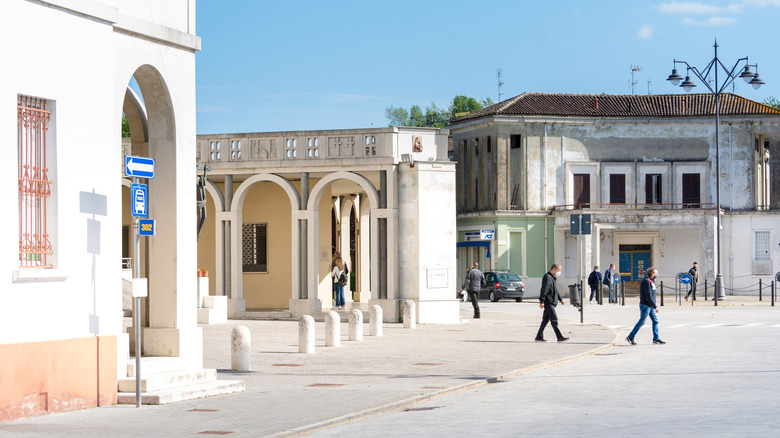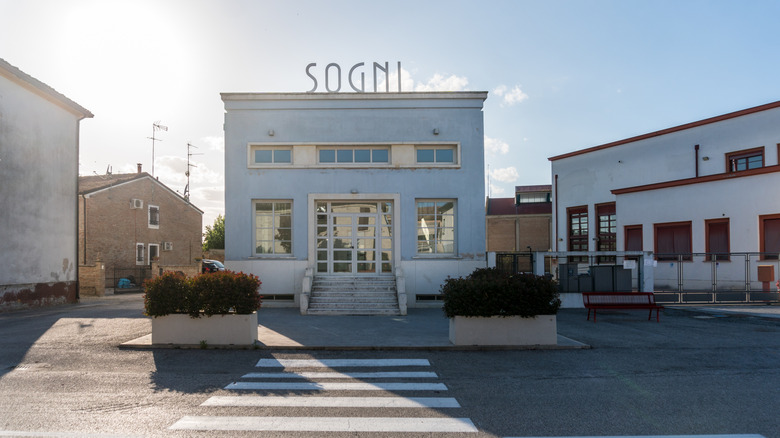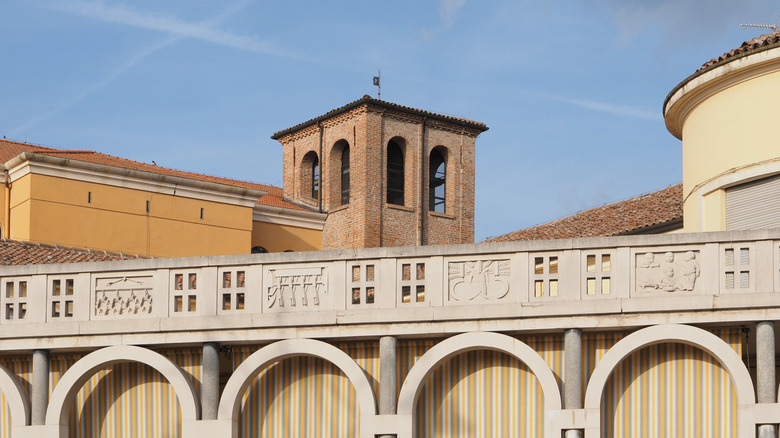Italy's 'Metaphysical City' Is A Unique Architectural Masterpiece With A Dark Origin Story
In the 1920s and '30s, a new style of architecture emerged under Italy's fascist regime. Defined by clean symmetry, stark geometric forms, and an emphasis on order over stylistic flair, Italian Rationalism became the standard of the time, shaping many of the building projects for Benito Mussolini's government. One of the movement's most famous buildings is the Palazzo della Civiltà Italiana, known as the "Square Colosseum," in Rome. The regime also created whole towns based off of the rationalist model, like Sabaudia, a quiet coastal town with a national park backdrop. All of the ideals and motifs of Italian Rationalism became most realized in the town of Tresigallo, often considered the capital of Italian Rationalism. Tresigallo is also known as the "Metaphysical City" because of its surreal, frozen-in-time appearance that serves as an architectural equivalent to the artwork of Italy's Metaphysical Painting movement.
Look at the paintings of Giorgio de Chirico, like his 1914 painting "The Enigma of a Day," and you'll see the kind of geometric buildings, evocative objects, and structured piazzas that closely resemble the city of Tresigallo. Many of the paintings predate Tresigallo's rebirth as a rationalist exemplar, though — its designer, Edmondo Rossoni, began transforming the town in the late 1920s and early 1930s. Unlike other towns that evolved naturally, the new Tresigallo was created almost all at once, and it hasn't changed much since the 1930s. Travel writer Lety for her blog Lety Goes On described Tresigallo as a "day trip into a parallel dimension on Earth."
The rationalist vision embodied by Tresigallo's central square
At the heart of Tresigallo, its Piazza della Repubblica is a semi-circular square that was designed to both harness the aesthetics of Italian fascism and serve as a backdrop to political gatherings. It was even formerly called the Piazza della Rivoluzione Fascista ("Square of the Fascist Revolution"). All around it are domineering, symmetrical buildings with sleek arcades. These buildings were part of the planned layout envisioned by Edmondo Rossoni, who had risen to the rank of minister of agriculture in Benito Mussolini's regime. Before then, Tresigallo was a poverty-stricken agricultural town. In a span of roughly five years, most of the town was rebuilt and expanded as an emblem of rationalist architecture and an attempt to combat poverty, and its population surged from about 500 to 9,000.
To the west of the square, walk along Via del Lavoro. You'll pass a building on this street with the word "sogni" ("dreams") written out on a large sign — this building has become a trademark of sorts of the city. It was originally a bathhouse but shortly after abandoned and repurposed as a temporary shelter. Right next to the "sogni" building is the House of Culture. Now a library, this curved concrete building once played an interesting role in the fascist social system as the center of the Italian Youth of the Lictor (the GIL). The GIL buildings were supposed to shape young people into ideal citizens, with a gym and educational offices to train the bodies and minds of young men.
Traces of life before and after fascism in Tresigallo
Stop back at the Piazza della Repubblica for an espresso or pizza before continuing to the eastern side of town. Sister Café on the square is a well-reviewed option for coffee, with 4.7 stars on Tripadvisor, and Brunetto is a convenient pizza restaurant just next door. Then, if you walk just five minutes east of Piazza della Repubblica, you'll get to another square, Piazza Italia. More rationalist architecture hems the square. One that stands out is the Church of Sant'Apollinare, which is a rare example of medieval Roman architecture blended with the modern, rationalist aesthetic. Its facade dates back to around 1044 A.D., though you'll notice how it's been embellished and updated with signature rationalist elements. On the church's portico, look closely at the artistic panels. They depict scenes of agrarian life, reflecting the town's medieval origins and agricultural history.
Another 18-minute walk east from the church lands you at the Palazzo Pio. Like the church, this palace hints at the town's pre-fascist roots. It was built in the early 1500s for nobles, likely as a hunting lodge. You generally can't enter the building, unfortunately, except during occasional, special events. The La Brace restaurant, which holds 4.2 stars on Google, is eight minutes by foot from the Palazzo Pio and is a great option for dinner.
You can reach Tresigallo from the Bologna Guglielmo Marconi Airport in about an hour's drive. It's also possible to get there by public transit in about two hours from Bologna, though it requires a few transfers. If you have time before or after, linger in Bologna to try some of the world's best pasta.


